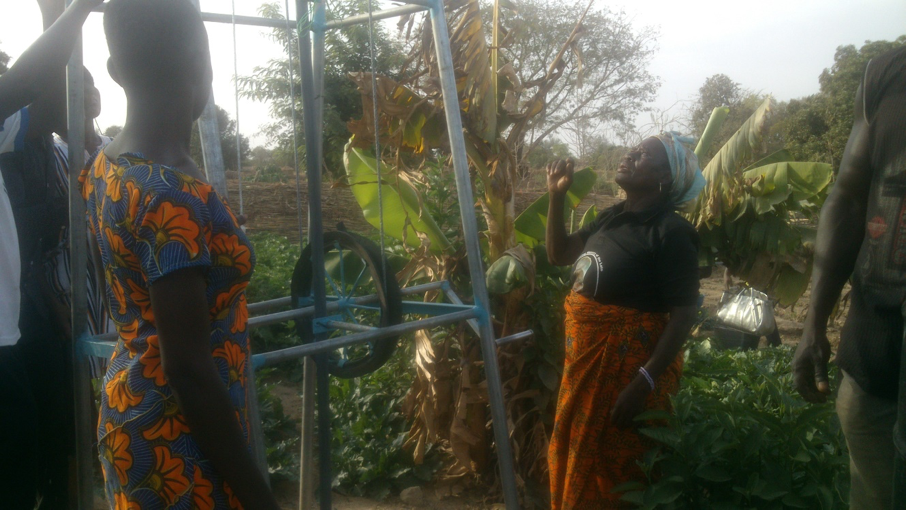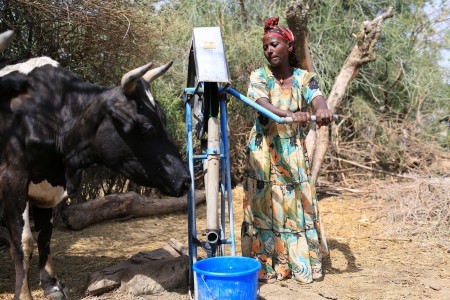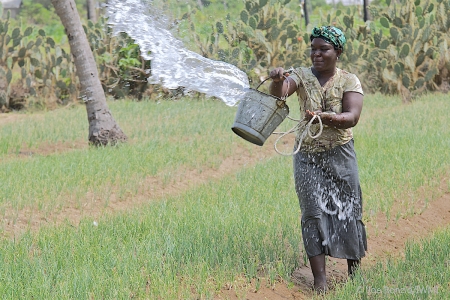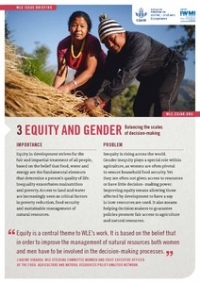
Integrating solutions that are equitable and socially inclusive has been one of the aims for the WLE projects in Volta Niger Basin. In seeking to solve the challenges facing rural women, an area of focus has been increasing women’s access to water through participation in irrigation schemes. This has been done by identifying the constraints and opportunities for adopting existing irrigation technologies and management practices, and through the provision of gender-friendly irrigation technology.
Preliminary results from WLE Focal Region Projects in the Volta Basin show that women’s adoption of water lifting technologies in irrigation is lower than that of men notwithstanding efforts to provide gender friendly technologies. A study of irrigation schemes in Ghana showed that men adopted water lifting technologies more than women. Although a previous study indicated that women easily adopted the use of canal in irrigation technologies under small reservoirs, the seemingly high number of women adopting canal irrigation is still lower as compared to men. Several visits to different communities in Northern Ghana led us to think of a new question in response to this Big Question about what to ask to understand gender dynamics in irrigation: what will it take for women to adopt an irrigation technology?
Here are some thoughts to consider in response:
Technology: The development of irrigation technology should not be limited to how gender friendly the technology is; that said, we should pay special attention to how beneficial the technology is for women. Evidence coming from the field shows that the decision to adopt an irrigation technology is not only dependent on the nature of the technology itself, but on a host of other factors, such as the costs incurred by a given piece of technology. Women tend to look at the total cost of the technology—the initial investment costs, the cost of operating the technology, and a number of other costs. If the overall cost as compared to the yields they make is not profitable, women are most likely not to invest in the technology. Even if a piece of technology might be useful and make women’s lives easier, they might not adopt it because they do not have the funds to invest in it.
Labour: Another area of concern for women is the labour needed for irrigation farming. Ground water extraction for irrigation, although highly prevalent in the Upper East region of Ghana, has been identified to be dominated by men. The technologies for extraction has been found to be generally labour intensive for women, hence their limitation. Digging of wells and dugouts is labour intensive, and it is done by men; women may have to hire labourers. Another area of concern for women is fences, and labour needed to fix them: livestock and other foraging animals can destroy crop farms. Most women do not have the time or available labour to construct fences around their irrigable land. Hiring of labour—whether for wells and dugouts or for fences around crops—requires further financial resources. Finding these factors stressful, some women abandon the use of irrigation technologies and the implementation schemes they require. Thus, for women to fully adopt an irrigation solution, the technological requirements (in terms of labour) should fit within what they have access to.
Socio-cultural norms and beliefs: Further constraints on technology adoption found in communities are related to government policy and social biases against women. A clear example is the tension between the policy on access to land for irrigation and the societal perception of women’s roles as keepers of the home. To date, very few women own irrigable lands in government- and community- managed schemes in Northern Ghana: irrigable lands are mainly allocated to household heads—men—without consideration for women, as women are seen as dependents of their husbands. Lack of access to land also impedes the ability of women to adopt irrigation technologies such as permanent shallow wells for groundwater extraction. In cases where women have had equal access to lands and technology for irrigation, they have also traditionally been responsible for social reproduction activities like cooking, cleaning, and fetching water, which limit the amount of time they are able to spend on their farms as compared to their male counterparts.
Changing gender roles will not come easily; however, providing energy and time saving technologies for women for their non-agricultural activities can mean more time saved for productive activities on farms. Women will adopt irrigation technologies when the necessary steps are taken to ensure that technologies made available for them can allow them to save on labour and capital.














Comments
This is such a nice blog to read. It is an interesting article. You have spoken your thoughts very well in this. https://idis.uonbi.ac.ke/
Add new comment